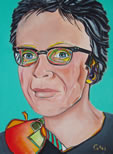useNature.com ... Holistic Therapies and Arthritis
Arthritis & Natural Therapies
Natural Holistic Health
useNature's Lifestyle Magazine & Holistic Articles
Arthritis & Natural Therapies
Article by © Dieter L. N.D.-D.C.H.-D.M.H.-D.H
Arthritis
WHAT IS IT AND WHY?
Arthritis is a common problem and is wide spread in the community. It can effect any joint, but also involve surrounding structures such as tendons, ligaments and cartilage.
The genreal term Arthritis actually describes a variety of conditions, with the three most common forms being Osteoarthritis, Rheumatoid Arthritis and Gout.
Natural Therapy Suggestion:
The treatment or management steps are different for each type of arthritis.
However, be advised that we strongly recommend that you consult a GP and follow that up with consulting a Naturopath, or similar Natural Holistic Practitioner.
Osteoarthritis
Symptoms: e.g. cold and stiff joints may be relieved by applying
heat.
Heat-wheat packs and
warming rubs or ointments.
Weigh loss is recommended for all Arthritic Conditions, simply to relives stress on individual joints.
A Glucosamine Sulphate supplement to enhance the healing and preservation of Cartilage may also help.
Ginger has been used for hundred of years, it can be used as a food supplement and as a tea.
Boswellia is an Ayurvedic plant treatment and it contains anti-inflammatory substances. It works specifically well in combination with Curcumin, which is Turmeric, again a good herb to use in cooking.
Please see the article about Ayurveda-Osteoarthritis - Ayurvedic food supplements.
For prevention, as mentioned above... obesity will increase the risk of developing Osteoarthitis. Regular exercise and staying injury free will go a long way towards staying healthy.
Diet is of vital importance in all forms of Arthritis, a well balanced anti-inflammatory diet is recommend, please read the diet article .
Rheumatoid Arthritis
Symptoms: (hot and swollen joints) will benefit from the application of a cold packs and a cooling cream containing homoeopathic and herbs.
Herbs have been traditionally used to help this condition.
However for many years now, Omega-3 fatty acids have been proven to be of benefit as an anti-inflammatory. Please combine this with above diet and plenty of cold water fish. Many other supplement can be of help, as well as what is mentioned for Osteoarthritis.
Herbal tinctures works best if mixed to individual requirements. - White willow may help with the pain.
Another substance helpful is Gamma-linolenic acid, found in borage, black currant seed and evening primrose oils.
Gout ...
... is aggravated by alcohol intake and purine-rich foods e.g. organ meats and shellfish.
Avoiding these foods, managing stress, and losing weight gradually if obese will help to relieve the symptoms of gout.
Some nutritional supplements may also be helpful such as vitamin B6 which helps to convert uric acid into harmless compounds.
A very old home remedy which seems to help is eating 10 to 15 sour cherries per day.
Magnetic devices may help to relieve Arthritic pain too.
These are small, padded magnets which, when placed against the body, create a therapeutic magnetic field.
Acupuncture provides patients with relief from the pain of Arthritis.
Massage Therapy can be of great help, and can relieve a lot of pain as well as stiffness.
There are many other natural pain relieving nutritional supplements available. These may contain herbs such as Willow Bark which has proven pain relieving properties.
Essential oils may be beneficial in reducing the severity of Arthritic pain
e.g. Roman chamomile, Lavender, Clary sage, Rosemary and Peppermint.
A few drops of these oils may be added to a bath or mixed into a cream that is applied to the skin.
Ask your Naturopath, Aroma therapist or Herbalist for advice about which oils would be most helpful for you and how to use them.
Exercise - Yoga
After checking with your your GP - Health Care Professional, 20 to 30 minutes of gentle and continuous exercise is recommended. Walking and swimming are examples of gentle exercise that may help reduce pain and stiffness, particularly in the joints, muscles, ligaments and tendons of the body.
Personally I would recommend Yoga as well, followed by meditation.
The benefits of exercise include: pain management, muscle strengthening, fitness, mobility, decreasing stress and depression associated with the loss of independence and work capacity, decreased dependence on others and living a greater quality of life.
The mode of exercise you decide on will be entirely be dependent on your fitness and capabilities. However, you need to ensure that both fitness activities and strength activities are included.
Fitness activities will assist in overall general fitness and weight maintenance, whilst strength training will assist in maintaining and developing strong muscles and joints.
Fitness activities that are the most beneficial for Arthritis sufferers are those that include rhythmical movements that can be performed over an extended period such as: brisk walking, hydrotherapy, aqua aerobics, group exercise classes, lawn bowls, tennis.
For strength training, Arthritis Australia recommends using isometric exercises for Arthritis sufferers as they strengthen the muscles without moving the joint.
When performing your physical activity it is also important to remember to move the joints through their full range of motion.
Compiled by:
PS: To be part of the useNature Directory, click > list your Healing Business
Disclaimer:
The information provided in this article is intended for general use and for personal interest only. It should not be used or understood as suggestion or medical advice.
Dieter Lüske
N.D.-D.C.H.-D.M.H.-D.H
Buy Now
It happened in the seventies
A Memoir of Love, Colliding Worlds and a House on a Hill
Intriguing story of personal risk-taking, self-discovery and profound change.
Dieter Luske
author . writer . editor
Related Information:
© 1998 - 2025 useNature.com: Australia - Natural Health and Lifestyle - Holistic Health Information Services
Site Map - Terms / Privacy - Global Health | Free Alpha Music | Photography | Natural Links |


